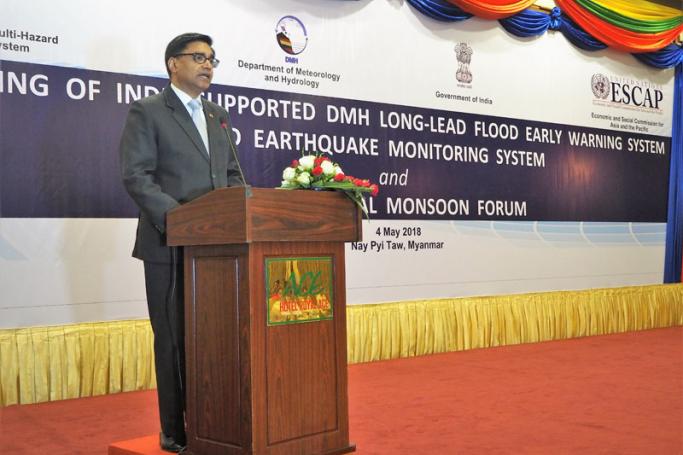The Ambassador of India, Mr. Vikram Misri, has inaugurated two projects supported by the Government of India – for developing Long-Lead Flood Early Warning System and Earthquake Monitoring System in Myanmar.
The announcement was made at a press conference in Yangon on 4 May.
Both the systems, housed in the Department of Meteorology and Hydrography (DMH) of the Ministry of Transport and Communications in Nay Pyi Taw, were inaugurated in the presence of Deputy Minister for Transport and Communication U Kyaw Myo. The systems, developed under financial and technical assistance from the Government of India channelled via Regional Integrated Multi Hazard Early Warning System for Africa and Asia (RIMES), have been tested and verified and are now fully integrated with existing Myanmar systems.
Under the Flood Warning System, 12 automatic water level stations and three automatic weather stations have been established and under the Earthquake Monitoring System, 10 telemetered seismic stations have been added to the eight station network of the DMH.
Speaking on the occasion, Ambassador Misri said that this was an opportune time to inaugurate these projects as the nation had only recently observed the 10th anniversary of Cyclone Nargis, the worst natural disaster in the recorded history of Myanmar.
“Extreme events such as Nargis can seriously undermine development gains, with the impact felt most by the poor and vulnerable sections of society. While such natural disasters cannot be prevented, their impact can nevertheless be mitigated considerably through access to prior information that enables preparation and mitigation of damage. It is not always true that disasters strike without warning and whatever we can do to ensure that there is adequate warning to protect against them should be done. It is only appropriate therefore that we are gathered here today to inaugurate the new Government of India-supported projects in Myanmar for long lead flood early warning and earthquake monitoring,” the Ambassador said.
Enhancing Myanmar’s capacity for better forecasting and monitoring extreme weather events such as Nargis, said Ambassador Misri, would go a long way towards better preparation and mitigation of damage from such natural disasters.
“Early warning information that is effectively communicated, well understood, and integrated into decision-making processes can help not only in managing risks, but also in optimizing benefits from potentially favourable climate conditions. Aware of the country’s risk context and the importance of shielding development prospects from these risks, Myanmar’s Department of Meteorology and Hydrology prepared a proposal in 2011 to develop and implement a flood forecasting and early warning system with support from the Government of India within the Regional Integrated Multi-Hazard Early Warning System cooperation framework. In 2012, the Government of India announced its acceptance of the proposal at the 12th RIMES Council Meeting in New Delhi and in 2014, funding for the proposed project was sanctioned by the Ministry of Earth Sciences of the Government of India, together with another RIMES project to enhance Myanmar’s earthquake monitoring capacity,” he said.
Ambassador Misri also highlighted the participatory nature of the projects whereby Myanmar experts were involved from start to end. He also underlined the usage of relevant scientific and technological tools that avoided unnecessary financial burdens on the host country and the back-up that was always available to the systems through linkages with key organisations in India, Europe and elsewhere.
The projects, he said, were a splendid example of sustainable cooperation that leveraged institutional resources from within the country and provided an alternative model for the development partner – beneficiary country relationship.
You are viewing the old site.
Please update your bookmark to https://eng.mizzima.com.
Mizzima Weekly Magazine Issue...
14 December 2023
Spring Revolution Daily News f...
13 December 2023
New UK Burma sanctions welcome...
13 December 2023
Spring Revolution Daily News f...
12 December 2023
Spring Revolution Daily News f...
11 December 2023
Spring Revolution Daily News f...
08 December 2023
Spring Revolution Daily News f...
07 December 2023
Diaspora journalists increasin...
07 December 2023
China blasts potential US investment curbs as 'economic coercion'












